Report: Sustainable Tourism Development in the Philippines
VerifiedAdded on 2020/07/23
|13
|4307
|115
Report
AI Summary
This report provides a comprehensive analysis of sustainable tourism development, focusing on the Philippines as an emerging tourism destination. The report explores stakeholder support in tourism planning, comparing the advantages and disadvantages of public and private sector involvement. It examines tourism development planning at international, national, and local levels, highlighting the significance of interactive planning systems. The report also discusses methods for measuring tourist impact, conflict resolution strategies, and the analysis of balancing supply and demand within the tourism sector. Furthermore, it addresses current issues associated with tourism development in developing countries and offers recommendations for future sustainable tourism development. The report emphasizes the importance of environmental, social, and economic considerations for long-term success.
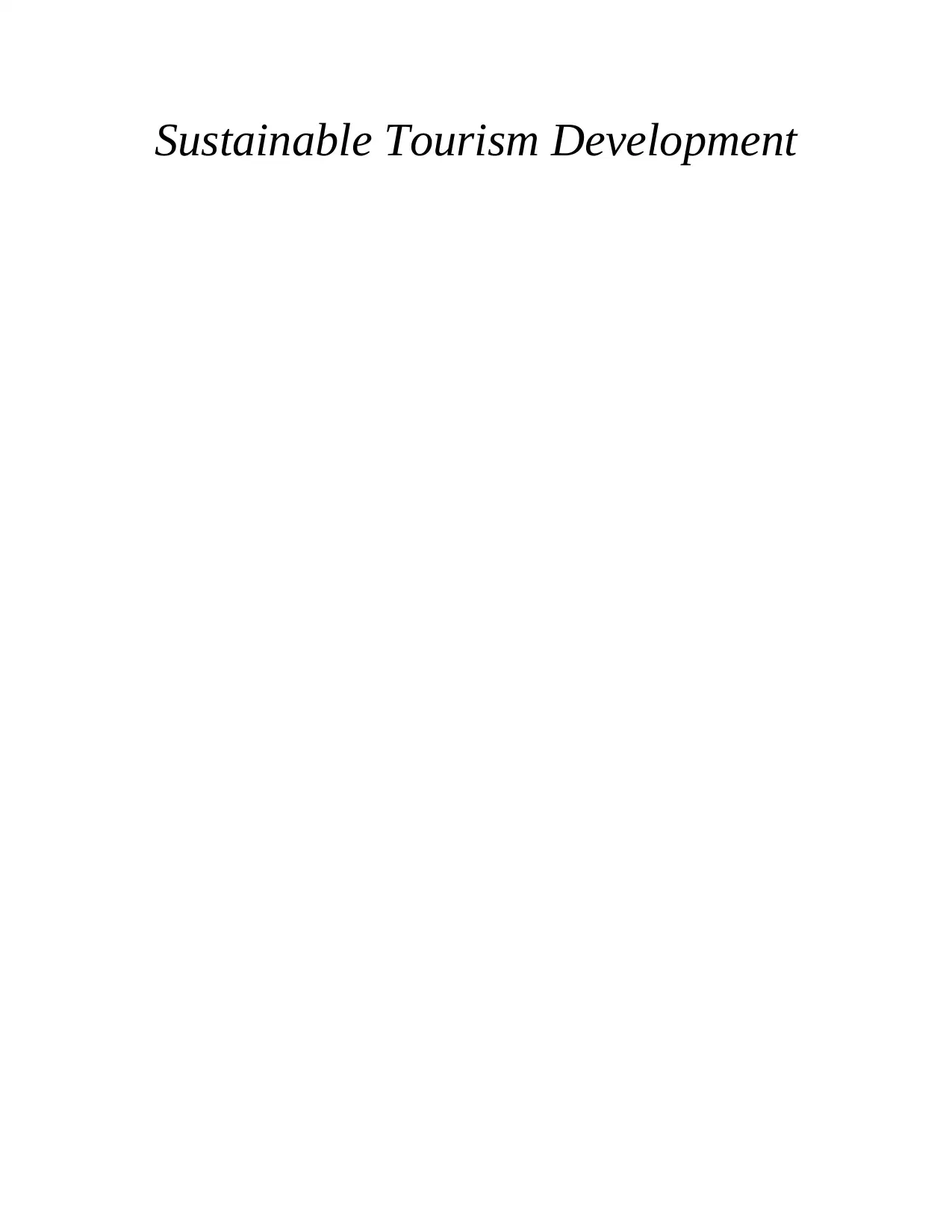
Sustainable Tourism Development
Paraphrase This Document
Need a fresh take? Get an instant paraphrase of this document with our AI Paraphraser
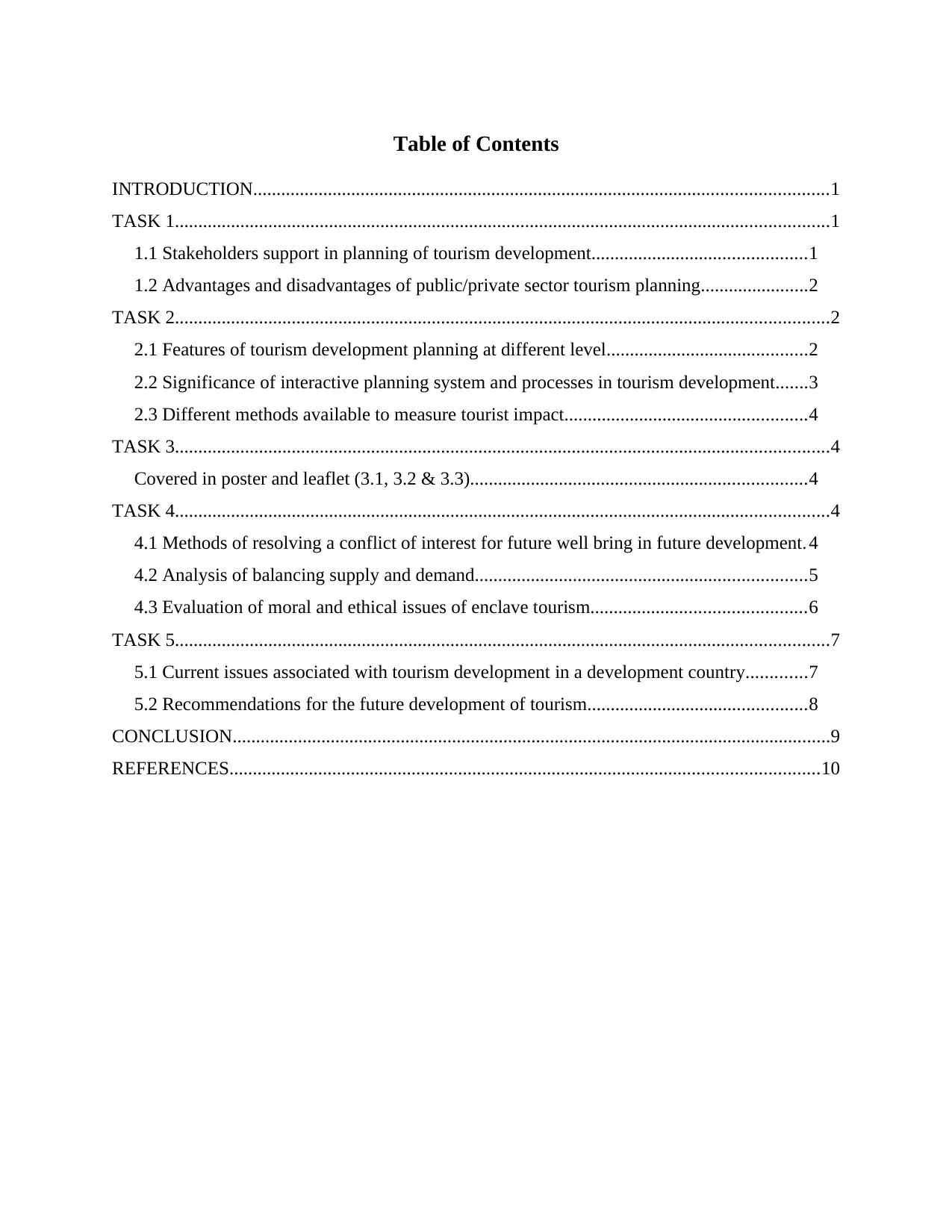
Table of Contents
INTRODUCTION...........................................................................................................................1
TASK 1............................................................................................................................................1
1.1 Stakeholders support in planning of tourism development..............................................1
1.2 Advantages and disadvantages of public/private sector tourism planning.......................2
TASK 2............................................................................................................................................2
2.1 Features of tourism development planning at different level...........................................2
2.2 Significance of interactive planning system and processes in tourism development.......3
2.3 Different methods available to measure tourist impact....................................................4
TASK 3............................................................................................................................................4
Covered in poster and leaflet (3.1, 3.2 & 3.3)........................................................................4
TASK 4............................................................................................................................................4
4.1 Methods of resolving a conflict of interest for future well bring in future development. 4
4.2 Analysis of balancing supply and demand.......................................................................5
4.3 Evaluation of moral and ethical issues of enclave tourism..............................................6
TASK 5............................................................................................................................................7
5.1 Current issues associated with tourism development in a development country.............7
5.2 Recommendations for the future development of tourism...............................................8
CONCLUSION................................................................................................................................9
REFERENCES..............................................................................................................................10
INTRODUCTION...........................................................................................................................1
TASK 1............................................................................................................................................1
1.1 Stakeholders support in planning of tourism development..............................................1
1.2 Advantages and disadvantages of public/private sector tourism planning.......................2
TASK 2............................................................................................................................................2
2.1 Features of tourism development planning at different level...........................................2
2.2 Significance of interactive planning system and processes in tourism development.......3
2.3 Different methods available to measure tourist impact....................................................4
TASK 3............................................................................................................................................4
Covered in poster and leaflet (3.1, 3.2 & 3.3)........................................................................4
TASK 4............................................................................................................................................4
4.1 Methods of resolving a conflict of interest for future well bring in future development. 4
4.2 Analysis of balancing supply and demand.......................................................................5
4.3 Evaluation of moral and ethical issues of enclave tourism..............................................6
TASK 5............................................................................................................................................7
5.1 Current issues associated with tourism development in a development country.............7
5.2 Recommendations for the future development of tourism...............................................8
CONCLUSION................................................................................................................................9
REFERENCES..............................................................................................................................10
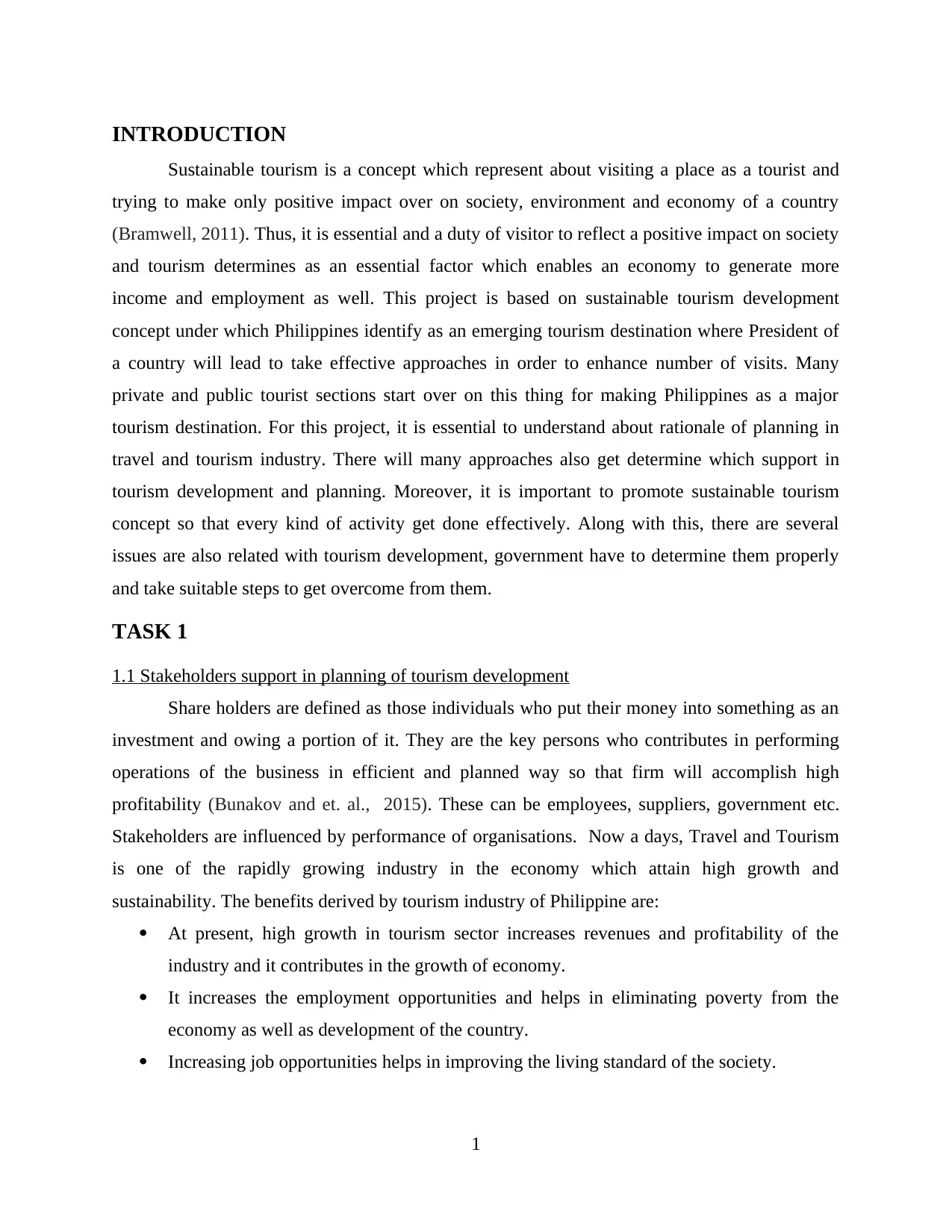
INTRODUCTION
Sustainable tourism is a concept which represent about visiting a place as a tourist and
trying to make only positive impact over on society, environment and economy of a country
(Bramwell, 2011). Thus, it is essential and a duty of visitor to reflect a positive impact on society
and tourism determines as an essential factor which enables an economy to generate more
income and employment as well. This project is based on sustainable tourism development
concept under which Philippines identify as an emerging tourism destination where President of
a country will lead to take effective approaches in order to enhance number of visits. Many
private and public tourist sections start over on this thing for making Philippines as a major
tourism destination. For this project, it is essential to understand about rationale of planning in
travel and tourism industry. There will many approaches also get determine which support in
tourism development and planning. Moreover, it is important to promote sustainable tourism
concept so that every kind of activity get done effectively. Along with this, there are several
issues are also related with tourism development, government have to determine them properly
and take suitable steps to get overcome from them.
TASK 1
1.1 Stakeholders support in planning of tourism development
Share holders are defined as those individuals who put their money into something as an
investment and owing a portion of it. They are the key persons who contributes in performing
operations of the business in efficient and planned way so that firm will accomplish high
profitability (Bunakov and et. al., 2015). These can be employees, suppliers, government etc.
Stakeholders are influenced by performance of organisations. Now a days, Travel and Tourism
is one of the rapidly growing industry in the economy which attain high growth and
sustainability. The benefits derived by tourism industry of Philippine are:
At present, high growth in tourism sector increases revenues and profitability of the
industry and it contributes in the growth of economy.
It increases the employment opportunities and helps in eliminating poverty from the
economy as well as development of the country.
Increasing job opportunities helps in improving the living standard of the society.
1
Sustainable tourism is a concept which represent about visiting a place as a tourist and
trying to make only positive impact over on society, environment and economy of a country
(Bramwell, 2011). Thus, it is essential and a duty of visitor to reflect a positive impact on society
and tourism determines as an essential factor which enables an economy to generate more
income and employment as well. This project is based on sustainable tourism development
concept under which Philippines identify as an emerging tourism destination where President of
a country will lead to take effective approaches in order to enhance number of visits. Many
private and public tourist sections start over on this thing for making Philippines as a major
tourism destination. For this project, it is essential to understand about rationale of planning in
travel and tourism industry. There will many approaches also get determine which support in
tourism development and planning. Moreover, it is important to promote sustainable tourism
concept so that every kind of activity get done effectively. Along with this, there are several
issues are also related with tourism development, government have to determine them properly
and take suitable steps to get overcome from them.
TASK 1
1.1 Stakeholders support in planning of tourism development
Share holders are defined as those individuals who put their money into something as an
investment and owing a portion of it. They are the key persons who contributes in performing
operations of the business in efficient and planned way so that firm will accomplish high
profitability (Bunakov and et. al., 2015). These can be employees, suppliers, government etc.
Stakeholders are influenced by performance of organisations. Now a days, Travel and Tourism
is one of the rapidly growing industry in the economy which attain high growth and
sustainability. The benefits derived by tourism industry of Philippine are:
At present, high growth in tourism sector increases revenues and profitability of the
industry and it contributes in the growth of economy.
It increases the employment opportunities and helps in eliminating poverty from the
economy as well as development of the country.
Increasing job opportunities helps in improving the living standard of the society.
1
⊘ This is a preview!⊘
Do you want full access?
Subscribe today to unlock all pages.

Trusted by 1+ million students worldwide
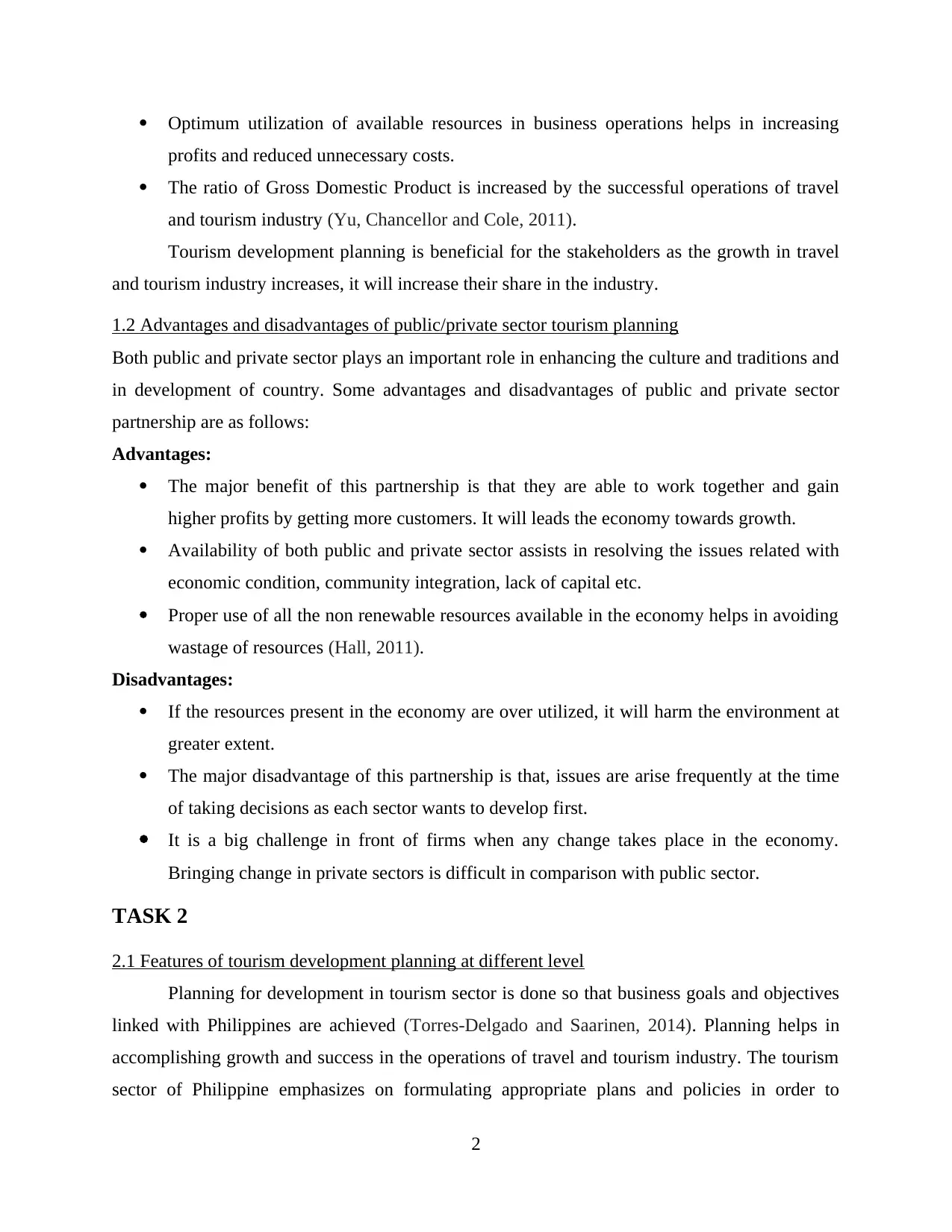
Optimum utilization of available resources in business operations helps in increasing
profits and reduced unnecessary costs.
The ratio of Gross Domestic Product is increased by the successful operations of travel
and tourism industry (Yu, Chancellor and Cole, 2011).
Tourism development planning is beneficial for the stakeholders as the growth in travel
and tourism industry increases, it will increase their share in the industry.
1.2 Advantages and disadvantages of public/private sector tourism planning
Both public and private sector plays an important role in enhancing the culture and traditions and
in development of country. Some advantages and disadvantages of public and private sector
partnership are as follows:
Advantages:
The major benefit of this partnership is that they are able to work together and gain
higher profits by getting more customers. It will leads the economy towards growth.
Availability of both public and private sector assists in resolving the issues related with
economic condition, community integration, lack of capital etc.
Proper use of all the non renewable resources available in the economy helps in avoiding
wastage of resources (Hall, 2011).
Disadvantages:
If the resources present in the economy are over utilized, it will harm the environment at
greater extent.
The major disadvantage of this partnership is that, issues are arise frequently at the time
of taking decisions as each sector wants to develop first.
It is a big challenge in front of firms when any change takes place in the economy.
Bringing change in private sectors is difficult in comparison with public sector.
TASK 2
2.1 Features of tourism development planning at different level
Planning for development in tourism sector is done so that business goals and objectives
linked with Philippines are achieved (Torres-Delgado and Saarinen, 2014). Planning helps in
accomplishing growth and success in the operations of travel and tourism industry. The tourism
sector of Philippine emphasizes on formulating appropriate plans and policies in order to
2
profits and reduced unnecessary costs.
The ratio of Gross Domestic Product is increased by the successful operations of travel
and tourism industry (Yu, Chancellor and Cole, 2011).
Tourism development planning is beneficial for the stakeholders as the growth in travel
and tourism industry increases, it will increase their share in the industry.
1.2 Advantages and disadvantages of public/private sector tourism planning
Both public and private sector plays an important role in enhancing the culture and traditions and
in development of country. Some advantages and disadvantages of public and private sector
partnership are as follows:
Advantages:
The major benefit of this partnership is that they are able to work together and gain
higher profits by getting more customers. It will leads the economy towards growth.
Availability of both public and private sector assists in resolving the issues related with
economic condition, community integration, lack of capital etc.
Proper use of all the non renewable resources available in the economy helps in avoiding
wastage of resources (Hall, 2011).
Disadvantages:
If the resources present in the economy are over utilized, it will harm the environment at
greater extent.
The major disadvantage of this partnership is that, issues are arise frequently at the time
of taking decisions as each sector wants to develop first.
It is a big challenge in front of firms when any change takes place in the economy.
Bringing change in private sectors is difficult in comparison with public sector.
TASK 2
2.1 Features of tourism development planning at different level
Planning for development in tourism sector is done so that business goals and objectives
linked with Philippines are achieved (Torres-Delgado and Saarinen, 2014). Planning helps in
accomplishing growth and success in the operations of travel and tourism industry. The tourism
sector of Philippine emphasizes on formulating appropriate plans and policies in order to
2
Paraphrase This Document
Need a fresh take? Get an instant paraphrase of this document with our AI Paraphraser
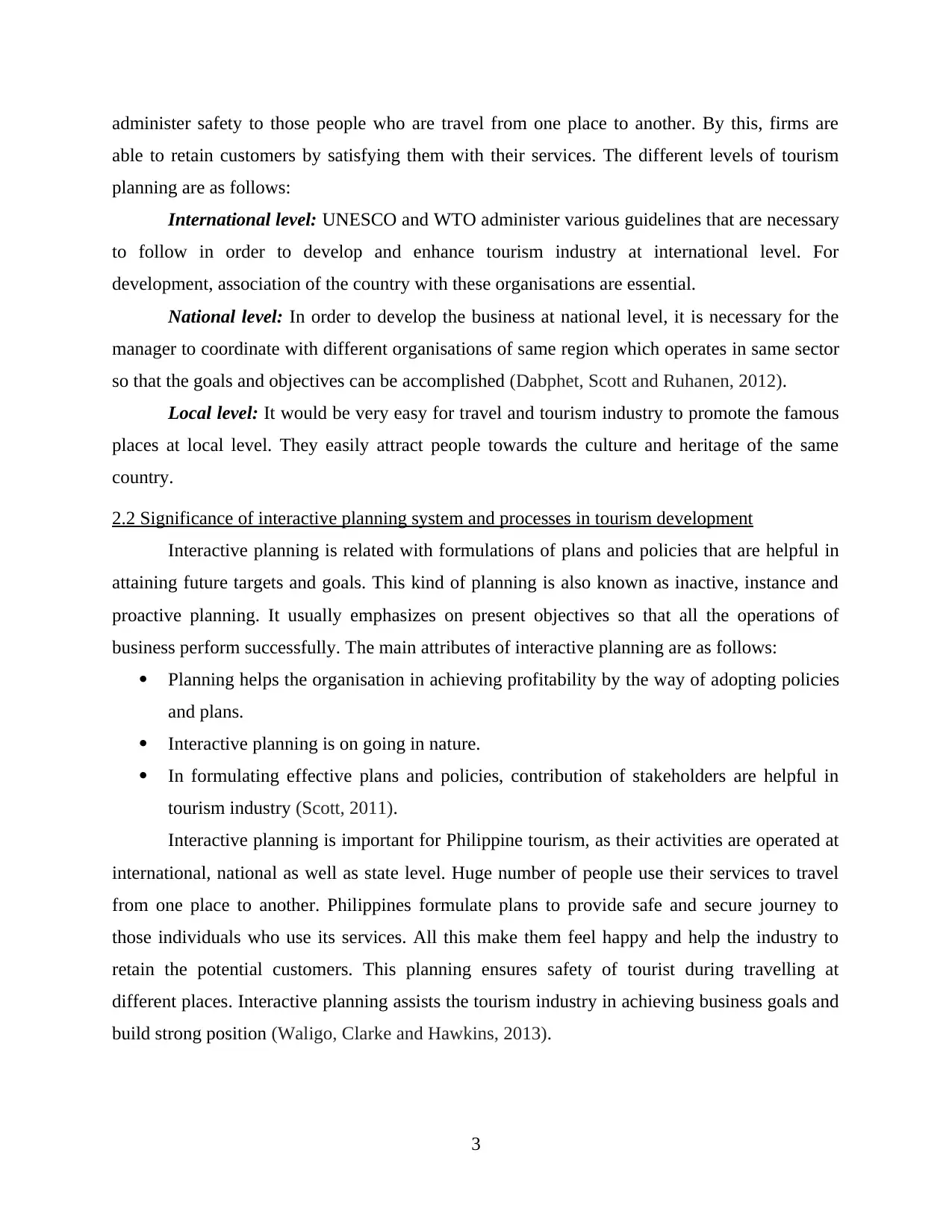
administer safety to those people who are travel from one place to another. By this, firms are
able to retain customers by satisfying them with their services. The different levels of tourism
planning are as follows:
International level: UNESCO and WTO administer various guidelines that are necessary
to follow in order to develop and enhance tourism industry at international level. For
development, association of the country with these organisations are essential.
National level: In order to develop the business at national level, it is necessary for the
manager to coordinate with different organisations of same region which operates in same sector
so that the goals and objectives can be accomplished (Dabphet, Scott and Ruhanen, 2012).
Local level: It would be very easy for travel and tourism industry to promote the famous
places at local level. They easily attract people towards the culture and heritage of the same
country.
2.2 Significance of interactive planning system and processes in tourism development
Interactive planning is related with formulations of plans and policies that are helpful in
attaining future targets and goals. This kind of planning is also known as inactive, instance and
proactive planning. It usually emphasizes on present objectives so that all the operations of
business perform successfully. The main attributes of interactive planning are as follows:
Planning helps the organisation in achieving profitability by the way of adopting policies
and plans.
Interactive planning is on going in nature.
In formulating effective plans and policies, contribution of stakeholders are helpful in
tourism industry (Scott, 2011).
Interactive planning is important for Philippine tourism, as their activities are operated at
international, national as well as state level. Huge number of people use their services to travel
from one place to another. Philippines formulate plans to provide safe and secure journey to
those individuals who use its services. All this make them feel happy and help the industry to
retain the potential customers. This planning ensures safety of tourist during travelling at
different places. Interactive planning assists the tourism industry in achieving business goals and
build strong position (Waligo, Clarke and Hawkins, 2013).
3
able to retain customers by satisfying them with their services. The different levels of tourism
planning are as follows:
International level: UNESCO and WTO administer various guidelines that are necessary
to follow in order to develop and enhance tourism industry at international level. For
development, association of the country with these organisations are essential.
National level: In order to develop the business at national level, it is necessary for the
manager to coordinate with different organisations of same region which operates in same sector
so that the goals and objectives can be accomplished (Dabphet, Scott and Ruhanen, 2012).
Local level: It would be very easy for travel and tourism industry to promote the famous
places at local level. They easily attract people towards the culture and heritage of the same
country.
2.2 Significance of interactive planning system and processes in tourism development
Interactive planning is related with formulations of plans and policies that are helpful in
attaining future targets and goals. This kind of planning is also known as inactive, instance and
proactive planning. It usually emphasizes on present objectives so that all the operations of
business perform successfully. The main attributes of interactive planning are as follows:
Planning helps the organisation in achieving profitability by the way of adopting policies
and plans.
Interactive planning is on going in nature.
In formulating effective plans and policies, contribution of stakeholders are helpful in
tourism industry (Scott, 2011).
Interactive planning is important for Philippine tourism, as their activities are operated at
international, national as well as state level. Huge number of people use their services to travel
from one place to another. Philippines formulate plans to provide safe and secure journey to
those individuals who use its services. All this make them feel happy and help the industry to
retain the potential customers. This planning ensures safety of tourist during travelling at
different places. Interactive planning assists the tourism industry in achieving business goals and
build strong position (Waligo, Clarke and Hawkins, 2013).
3
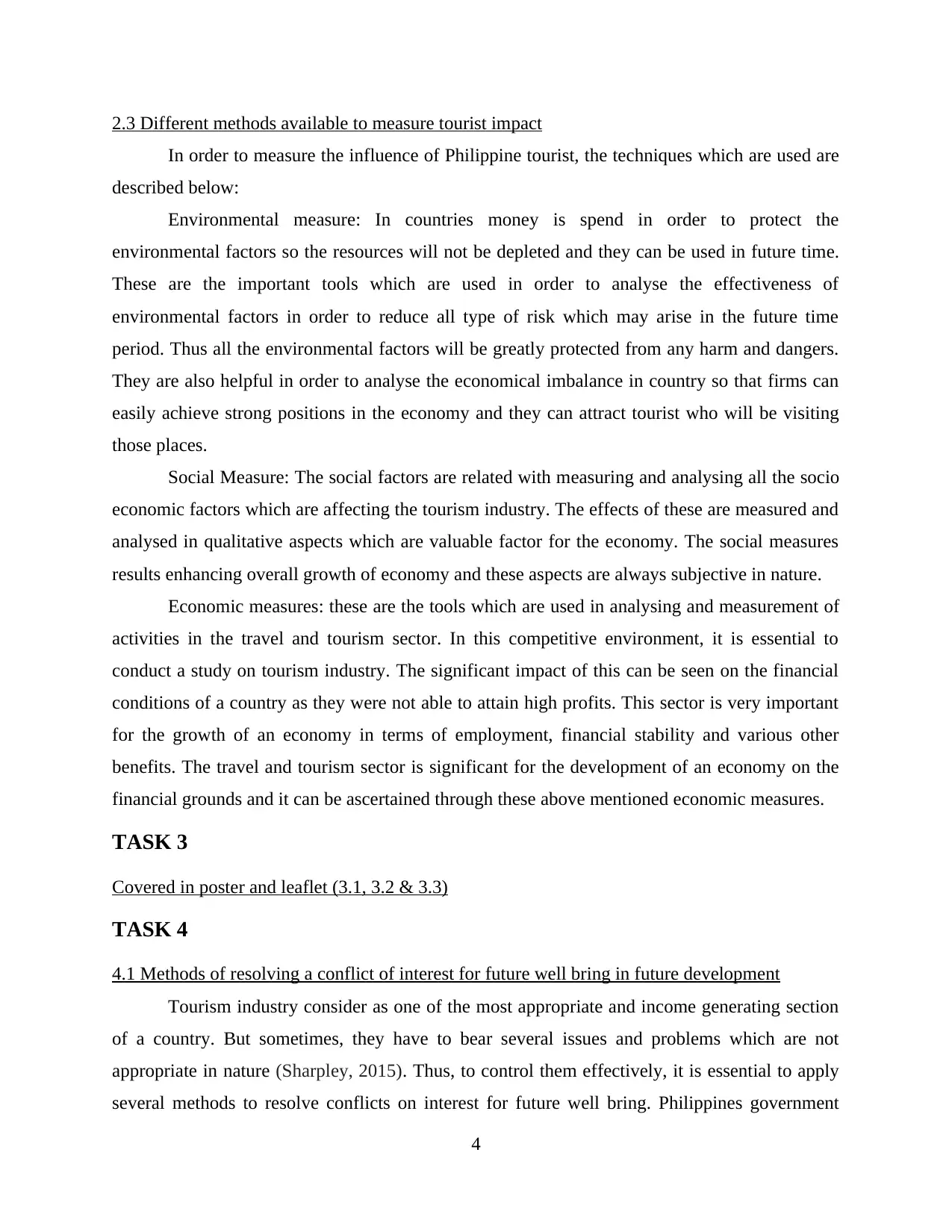
2.3 Different methods available to measure tourist impact
In order to measure the influence of Philippine tourist, the techniques which are used are
described below:
Environmental measure: In countries money is spend in order to protect the
environmental factors so the resources will not be depleted and they can be used in future time.
These are the important tools which are used in order to analyse the effectiveness of
environmental factors in order to reduce all type of risk which may arise in the future time
period. Thus all the environmental factors will be greatly protected from any harm and dangers.
They are also helpful in order to analyse the economical imbalance in country so that firms can
easily achieve strong positions in the economy and they can attract tourist who will be visiting
those places.
Social Measure: The social factors are related with measuring and analysing all the socio
economic factors which are affecting the tourism industry. The effects of these are measured and
analysed in qualitative aspects which are valuable factor for the economy. The social measures
results enhancing overall growth of economy and these aspects are always subjective in nature.
Economic measures: these are the tools which are used in analysing and measurement of
activities in the travel and tourism sector. In this competitive environment, it is essential to
conduct a study on tourism industry. The significant impact of this can be seen on the financial
conditions of a country as they were not able to attain high profits. This sector is very important
for the growth of an economy in terms of employment, financial stability and various other
benefits. The travel and tourism sector is significant for the development of an economy on the
financial grounds and it can be ascertained through these above mentioned economic measures.
TASK 3
Covered in poster and leaflet (3.1, 3.2 & 3.3)
TASK 4
4.1 Methods of resolving a conflict of interest for future well bring in future development
Tourism industry consider as one of the most appropriate and income generating section
of a country. But sometimes, they have to bear several issues and problems which are not
appropriate in nature (Sharpley, 2015). Thus, to control them effectively, it is essential to apply
several methods to resolve conflicts on interest for future well bring. Philippines government
4
In order to measure the influence of Philippine tourist, the techniques which are used are
described below:
Environmental measure: In countries money is spend in order to protect the
environmental factors so the resources will not be depleted and they can be used in future time.
These are the important tools which are used in order to analyse the effectiveness of
environmental factors in order to reduce all type of risk which may arise in the future time
period. Thus all the environmental factors will be greatly protected from any harm and dangers.
They are also helpful in order to analyse the economical imbalance in country so that firms can
easily achieve strong positions in the economy and they can attract tourist who will be visiting
those places.
Social Measure: The social factors are related with measuring and analysing all the socio
economic factors which are affecting the tourism industry. The effects of these are measured and
analysed in qualitative aspects which are valuable factor for the economy. The social measures
results enhancing overall growth of economy and these aspects are always subjective in nature.
Economic measures: these are the tools which are used in analysing and measurement of
activities in the travel and tourism sector. In this competitive environment, it is essential to
conduct a study on tourism industry. The significant impact of this can be seen on the financial
conditions of a country as they were not able to attain high profits. This sector is very important
for the growth of an economy in terms of employment, financial stability and various other
benefits. The travel and tourism sector is significant for the development of an economy on the
financial grounds and it can be ascertained through these above mentioned economic measures.
TASK 3
Covered in poster and leaflet (3.1, 3.2 & 3.3)
TASK 4
4.1 Methods of resolving a conflict of interest for future well bring in future development
Tourism industry consider as one of the most appropriate and income generating section
of a country. But sometimes, they have to bear several issues and problems which are not
appropriate in nature (Sharpley, 2015). Thus, to control them effectively, it is essential to apply
several methods to resolve conflicts on interest for future well bring. Philippines government
4
⊘ This is a preview!⊘
Do you want full access?
Subscribe today to unlock all pages.

Trusted by 1+ million students worldwide
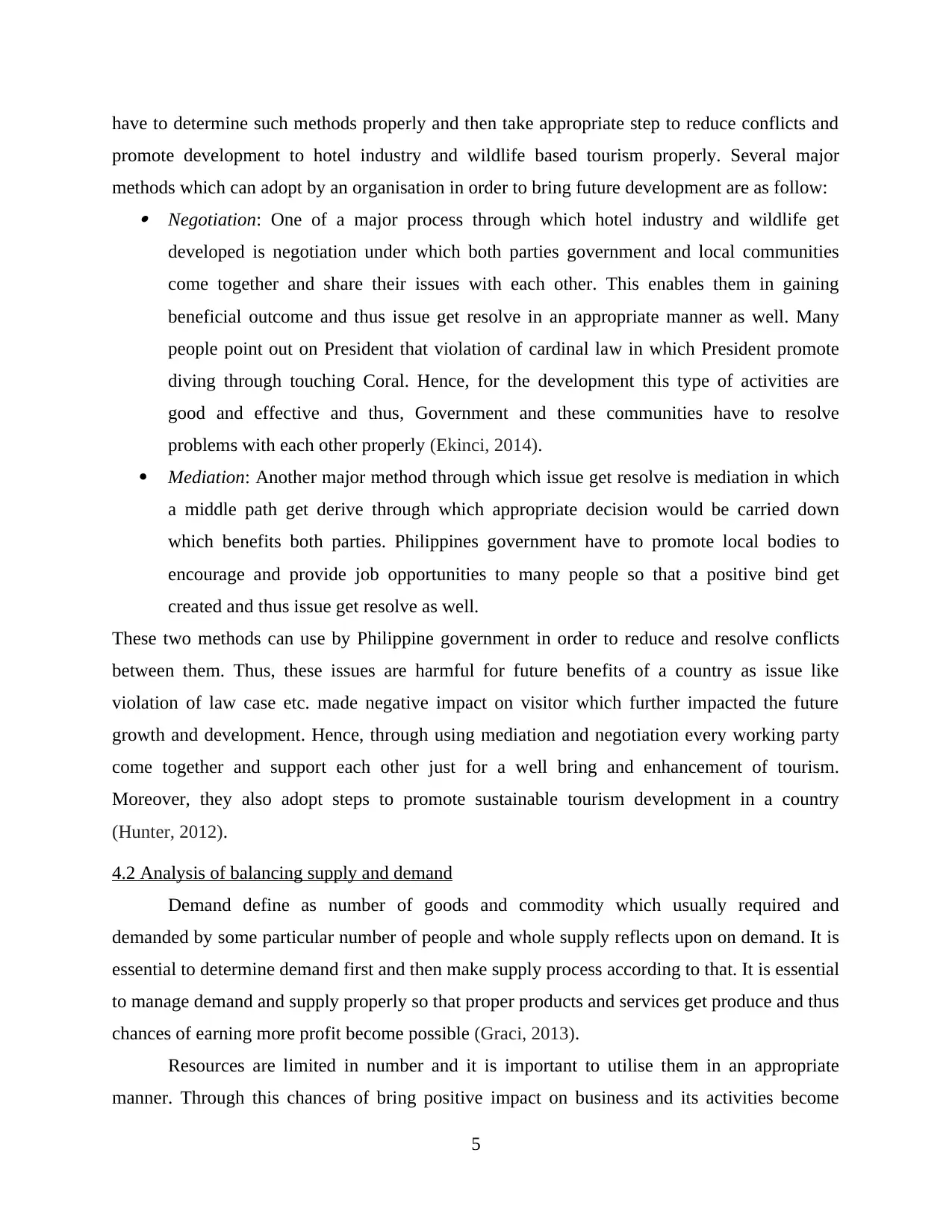
have to determine such methods properly and then take appropriate step to reduce conflicts and
promote development to hotel industry and wildlife based tourism properly. Several major
methods which can adopt by an organisation in order to bring future development are as follow: Negotiation: One of a major process through which hotel industry and wildlife get
developed is negotiation under which both parties government and local communities
come together and share their issues with each other. This enables them in gaining
beneficial outcome and thus issue get resolve in an appropriate manner as well. Many
people point out on President that violation of cardinal law in which President promote
diving through touching Coral. Hence, for the development this type of activities are
good and effective and thus, Government and these communities have to resolve
problems with each other properly (Ekinci, 2014).
Mediation: Another major method through which issue get resolve is mediation in which
a middle path get derive through which appropriate decision would be carried down
which benefits both parties. Philippines government have to promote local bodies to
encourage and provide job opportunities to many people so that a positive bind get
created and thus issue get resolve as well.
These two methods can use by Philippine government in order to reduce and resolve conflicts
between them. Thus, these issues are harmful for future benefits of a country as issue like
violation of law case etc. made negative impact on visitor which further impacted the future
growth and development. Hence, through using mediation and negotiation every working party
come together and support each other just for a well bring and enhancement of tourism.
Moreover, they also adopt steps to promote sustainable tourism development in a country
(Hunter, 2012).
4.2 Analysis of balancing supply and demand
Demand define as number of goods and commodity which usually required and
demanded by some particular number of people and whole supply reflects upon on demand. It is
essential to determine demand first and then make supply process according to that. It is essential
to manage demand and supply properly so that proper products and services get produce and thus
chances of earning more profit become possible (Graci, 2013).
Resources are limited in number and it is important to utilise them in an appropriate
manner. Through this chances of bring positive impact on business and its activities become
5
promote development to hotel industry and wildlife based tourism properly. Several major
methods which can adopt by an organisation in order to bring future development are as follow: Negotiation: One of a major process through which hotel industry and wildlife get
developed is negotiation under which both parties government and local communities
come together and share their issues with each other. This enables them in gaining
beneficial outcome and thus issue get resolve in an appropriate manner as well. Many
people point out on President that violation of cardinal law in which President promote
diving through touching Coral. Hence, for the development this type of activities are
good and effective and thus, Government and these communities have to resolve
problems with each other properly (Ekinci, 2014).
Mediation: Another major method through which issue get resolve is mediation in which
a middle path get derive through which appropriate decision would be carried down
which benefits both parties. Philippines government have to promote local bodies to
encourage and provide job opportunities to many people so that a positive bind get
created and thus issue get resolve as well.
These two methods can use by Philippine government in order to reduce and resolve conflicts
between them. Thus, these issues are harmful for future benefits of a country as issue like
violation of law case etc. made negative impact on visitor which further impacted the future
growth and development. Hence, through using mediation and negotiation every working party
come together and support each other just for a well bring and enhancement of tourism.
Moreover, they also adopt steps to promote sustainable tourism development in a country
(Hunter, 2012).
4.2 Analysis of balancing supply and demand
Demand define as number of goods and commodity which usually required and
demanded by some particular number of people and whole supply reflects upon on demand. It is
essential to determine demand first and then make supply process according to that. It is essential
to manage demand and supply properly so that proper products and services get produce and thus
chances of earning more profit become possible (Graci, 2013).
Resources are limited in number and it is important to utilise them in an appropriate
manner. Through this chances of bring positive impact on business and its activities become
5
Paraphrase This Document
Need a fresh take? Get an instant paraphrase of this document with our AI Paraphraser
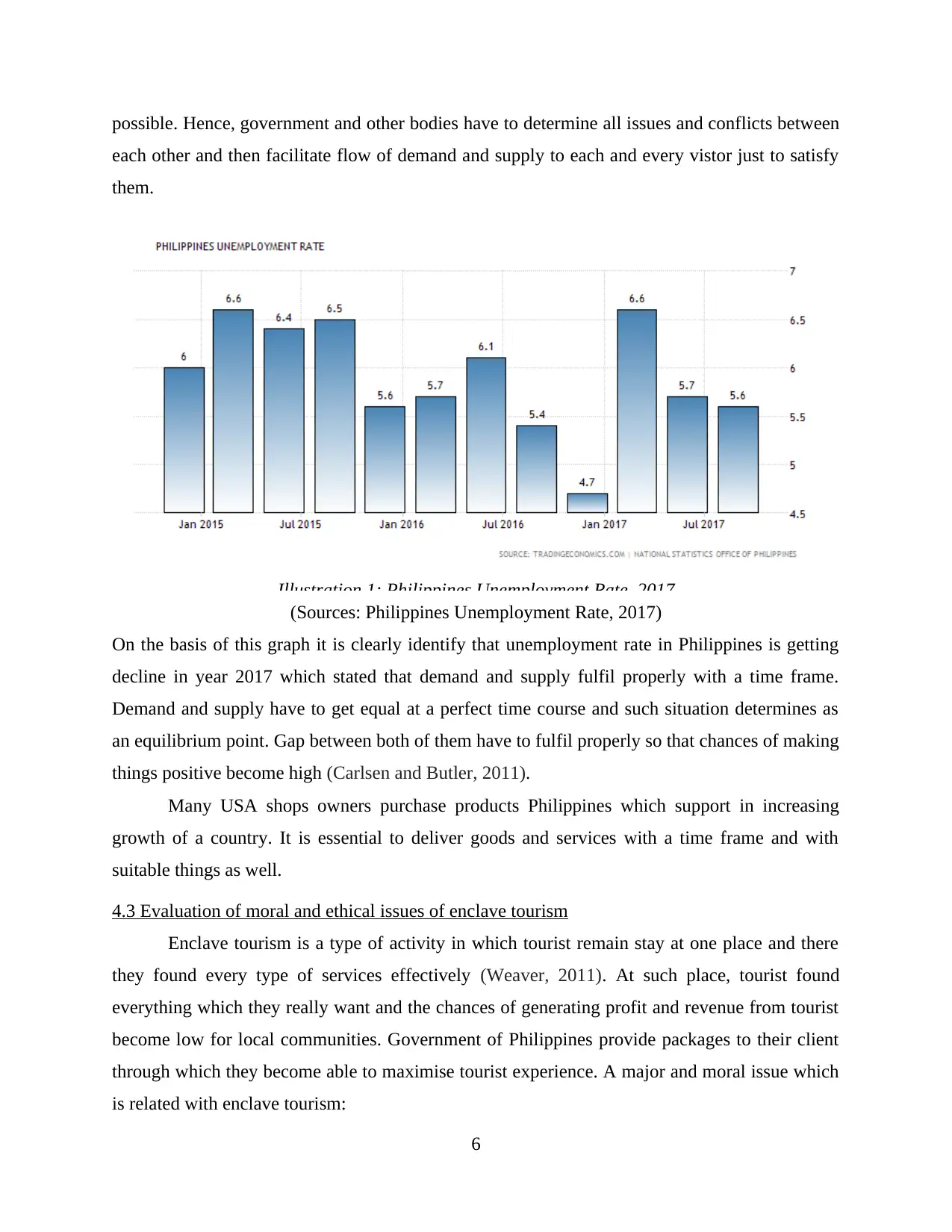
possible. Hence, government and other bodies have to determine all issues and conflicts between
each other and then facilitate flow of demand and supply to each and every vistor just to satisfy
them.
(Sources: Philippines Unemployment Rate, 2017)
On the basis of this graph it is clearly identify that unemployment rate in Philippines is getting
decline in year 2017 which stated that demand and supply fulfil properly with a time frame.
Demand and supply have to get equal at a perfect time course and such situation determines as
an equilibrium point. Gap between both of them have to fulfil properly so that chances of making
things positive become high (Carlsen and Butler, 2011).
Many USA shops owners purchase products Philippines which support in increasing
growth of a country. It is essential to deliver goods and services with a time frame and with
suitable things as well.
4.3 Evaluation of moral and ethical issues of enclave tourism
Enclave tourism is a type of activity in which tourist remain stay at one place and there
they found every type of services effectively (Weaver, 2011). At such place, tourist found
everything which they really want and the chances of generating profit and revenue from tourist
become low for local communities. Government of Philippines provide packages to their client
through which they become able to maximise tourist experience. A major and moral issue which
is related with enclave tourism:
6
Illustration 1: Philippines Unemployment Rate, 2017
each other and then facilitate flow of demand and supply to each and every vistor just to satisfy
them.
(Sources: Philippines Unemployment Rate, 2017)
On the basis of this graph it is clearly identify that unemployment rate in Philippines is getting
decline in year 2017 which stated that demand and supply fulfil properly with a time frame.
Demand and supply have to get equal at a perfect time course and such situation determines as
an equilibrium point. Gap between both of them have to fulfil properly so that chances of making
things positive become high (Carlsen and Butler, 2011).
Many USA shops owners purchase products Philippines which support in increasing
growth of a country. It is essential to deliver goods and services with a time frame and with
suitable things as well.
4.3 Evaluation of moral and ethical issues of enclave tourism
Enclave tourism is a type of activity in which tourist remain stay at one place and there
they found every type of services effectively (Weaver, 2011). At such place, tourist found
everything which they really want and the chances of generating profit and revenue from tourist
become low for local communities. Government of Philippines provide packages to their client
through which they become able to maximise tourist experience. A major and moral issue which
is related with enclave tourism:
6
Illustration 1: Philippines Unemployment Rate, 2017
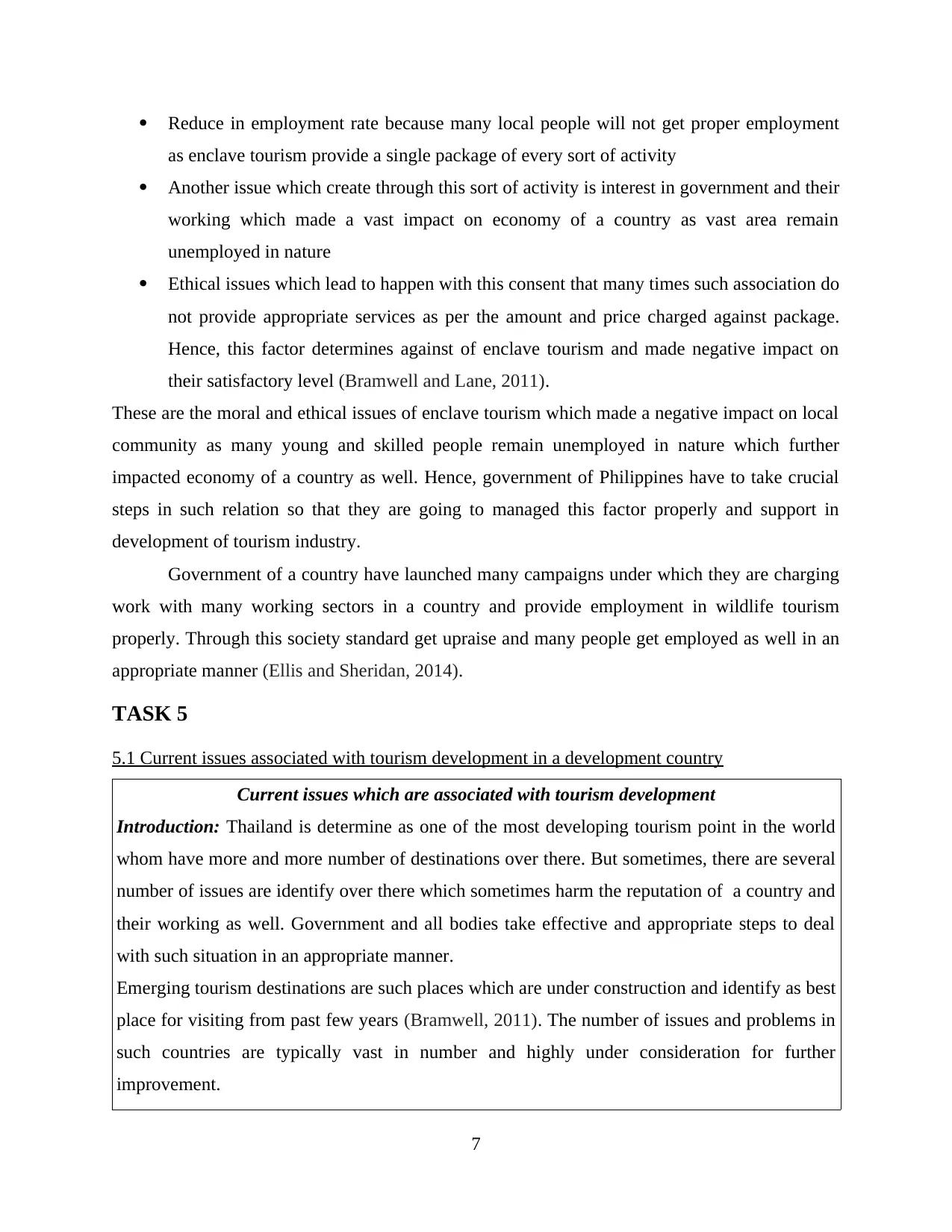
Reduce in employment rate because many local people will not get proper employment
as enclave tourism provide a single package of every sort of activity
Another issue which create through this sort of activity is interest in government and their
working which made a vast impact on economy of a country as vast area remain
unemployed in nature
Ethical issues which lead to happen with this consent that many times such association do
not provide appropriate services as per the amount and price charged against package.
Hence, this factor determines against of enclave tourism and made negative impact on
their satisfactory level (Bramwell and Lane, 2011).
These are the moral and ethical issues of enclave tourism which made a negative impact on local
community as many young and skilled people remain unemployed in nature which further
impacted economy of a country as well. Hence, government of Philippines have to take crucial
steps in such relation so that they are going to managed this factor properly and support in
development of tourism industry.
Government of a country have launched many campaigns under which they are charging
work with many working sectors in a country and provide employment in wildlife tourism
properly. Through this society standard get upraise and many people get employed as well in an
appropriate manner (Ellis and Sheridan, 2014).
TASK 5
5.1 Current issues associated with tourism development in a development country
Current issues which are associated with tourism development
Introduction: Thailand is determine as one of the most developing tourism point in the world
whom have more and more number of destinations over there. But sometimes, there are several
number of issues are identify over there which sometimes harm the reputation of a country and
their working as well. Government and all bodies take effective and appropriate steps to deal
with such situation in an appropriate manner.
Emerging tourism destinations are such places which are under construction and identify as best
place for visiting from past few years (Bramwell, 2011). The number of issues and problems in
such countries are typically vast in number and highly under consideration for further
improvement.
7
as enclave tourism provide a single package of every sort of activity
Another issue which create through this sort of activity is interest in government and their
working which made a vast impact on economy of a country as vast area remain
unemployed in nature
Ethical issues which lead to happen with this consent that many times such association do
not provide appropriate services as per the amount and price charged against package.
Hence, this factor determines against of enclave tourism and made negative impact on
their satisfactory level (Bramwell and Lane, 2011).
These are the moral and ethical issues of enclave tourism which made a negative impact on local
community as many young and skilled people remain unemployed in nature which further
impacted economy of a country as well. Hence, government of Philippines have to take crucial
steps in such relation so that they are going to managed this factor properly and support in
development of tourism industry.
Government of a country have launched many campaigns under which they are charging
work with many working sectors in a country and provide employment in wildlife tourism
properly. Through this society standard get upraise and many people get employed as well in an
appropriate manner (Ellis and Sheridan, 2014).
TASK 5
5.1 Current issues associated with tourism development in a development country
Current issues which are associated with tourism development
Introduction: Thailand is determine as one of the most developing tourism point in the world
whom have more and more number of destinations over there. But sometimes, there are several
number of issues are identify over there which sometimes harm the reputation of a country and
their working as well. Government and all bodies take effective and appropriate steps to deal
with such situation in an appropriate manner.
Emerging tourism destinations are such places which are under construction and identify as best
place for visiting from past few years (Bramwell, 2011). The number of issues and problems in
such countries are typically vast in number and highly under consideration for further
improvement.
7
⊘ This is a preview!⊘
Do you want full access?
Subscribe today to unlock all pages.

Trusted by 1+ million students worldwide
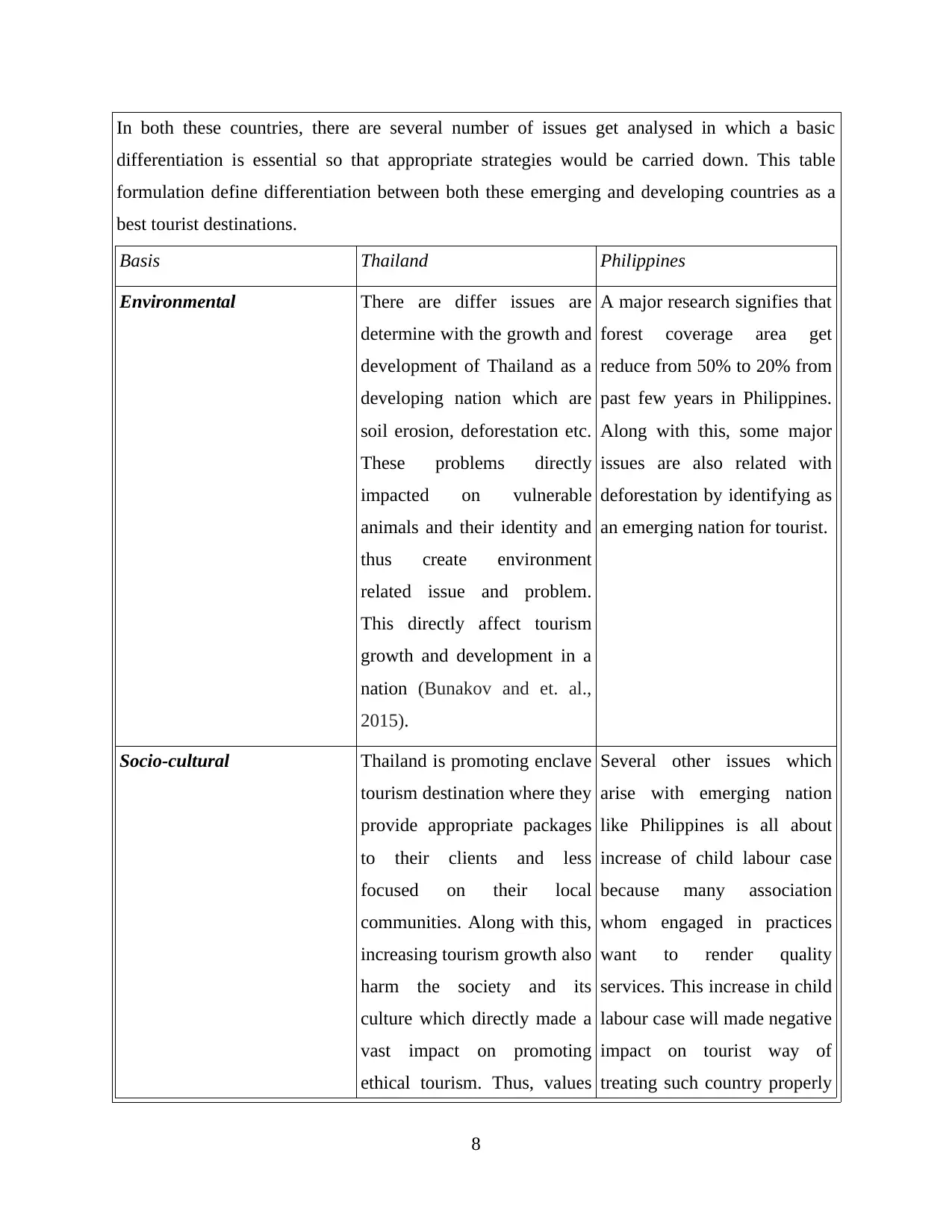
In both these countries, there are several number of issues get analysed in which a basic
differentiation is essential so that appropriate strategies would be carried down. This table
formulation define differentiation between both these emerging and developing countries as a
best tourist destinations.
Basis Thailand Philippines
Environmental There are differ issues are
determine with the growth and
development of Thailand as a
developing nation which are
soil erosion, deforestation etc.
These problems directly
impacted on vulnerable
animals and their identity and
thus create environment
related issue and problem.
This directly affect tourism
growth and development in a
nation (Bunakov and et. al.,
2015).
A major research signifies that
forest coverage area get
reduce from 50% to 20% from
past few years in Philippines.
Along with this, some major
issues are also related with
deforestation by identifying as
an emerging nation for tourist.
Socio-cultural Thailand is promoting enclave
tourism destination where they
provide appropriate packages
to their clients and less
focused on their local
communities. Along with this,
increasing tourism growth also
harm the society and its
culture which directly made a
vast impact on promoting
ethical tourism. Thus, values
Several other issues which
arise with emerging nation
like Philippines is all about
increase of child labour case
because many association
whom engaged in practices
want to render quality
services. This increase in child
labour case will made negative
impact on tourist way of
treating such country properly
8
differentiation is essential so that appropriate strategies would be carried down. This table
formulation define differentiation between both these emerging and developing countries as a
best tourist destinations.
Basis Thailand Philippines
Environmental There are differ issues are
determine with the growth and
development of Thailand as a
developing nation which are
soil erosion, deforestation etc.
These problems directly
impacted on vulnerable
animals and their identity and
thus create environment
related issue and problem.
This directly affect tourism
growth and development in a
nation (Bunakov and et. al.,
2015).
A major research signifies that
forest coverage area get
reduce from 50% to 20% from
past few years in Philippines.
Along with this, some major
issues are also related with
deforestation by identifying as
an emerging nation for tourist.
Socio-cultural Thailand is promoting enclave
tourism destination where they
provide appropriate packages
to their clients and less
focused on their local
communities. Along with this,
increasing tourism growth also
harm the society and its
culture which directly made a
vast impact on promoting
ethical tourism. Thus, values
Several other issues which
arise with emerging nation
like Philippines is all about
increase of child labour case
because many association
whom engaged in practices
want to render quality
services. This increase in child
labour case will made negative
impact on tourist way of
treating such country properly
8
Paraphrase This Document
Need a fresh take? Get an instant paraphrase of this document with our AI Paraphraser
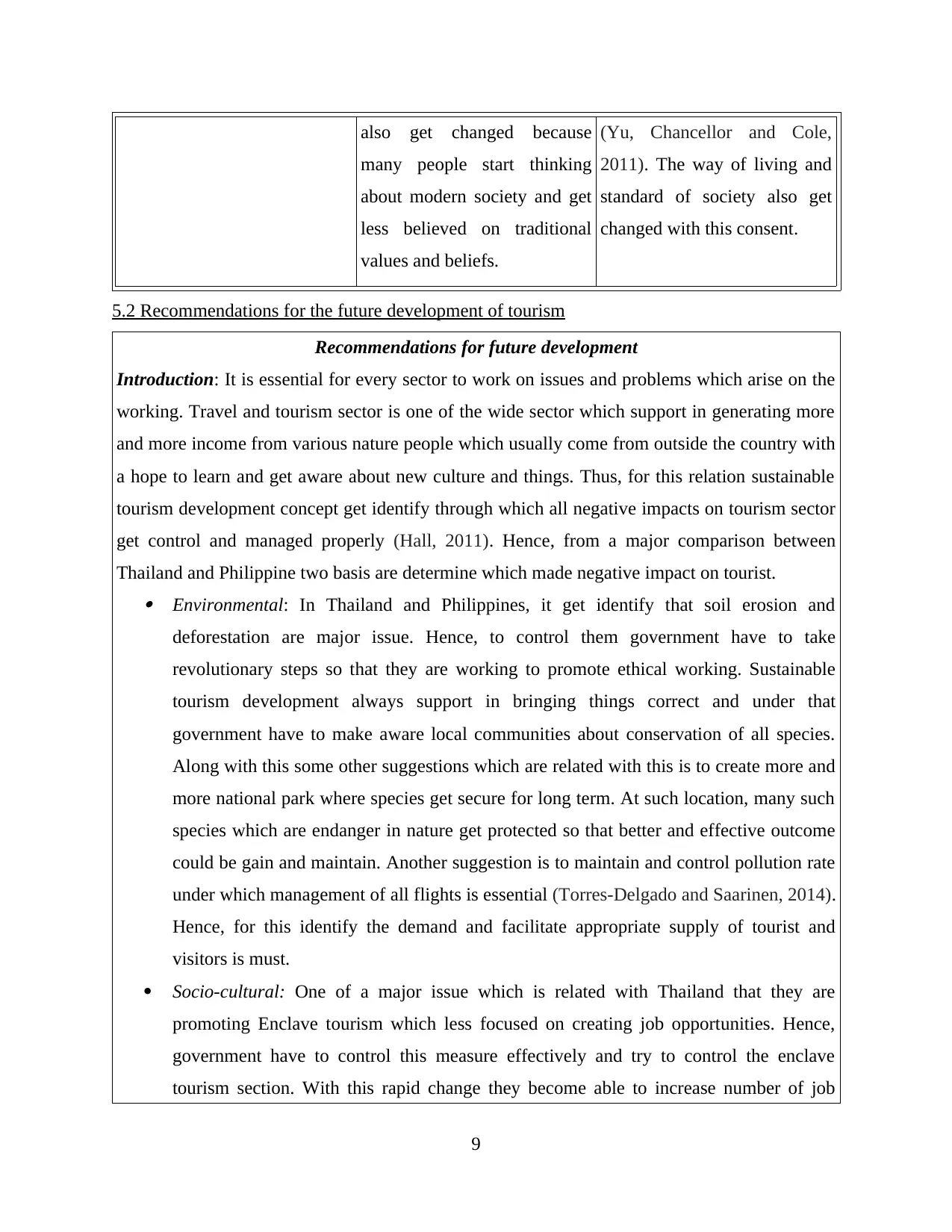
also get changed because
many people start thinking
about modern society and get
less believed on traditional
values and beliefs.
(Yu, Chancellor and Cole,
2011). The way of living and
standard of society also get
changed with this consent.
5.2 Recommendations for the future development of tourism
Recommendations for future development
Introduction: It is essential for every sector to work on issues and problems which arise on the
working. Travel and tourism sector is one of the wide sector which support in generating more
and more income from various nature people which usually come from outside the country with
a hope to learn and get aware about new culture and things. Thus, for this relation sustainable
tourism development concept get identify through which all negative impacts on tourism sector
get control and managed properly (Hall, 2011). Hence, from a major comparison between
Thailand and Philippine two basis are determine which made negative impact on tourist. Environmental: In Thailand and Philippines, it get identify that soil erosion and
deforestation are major issue. Hence, to control them government have to take
revolutionary steps so that they are working to promote ethical working. Sustainable
tourism development always support in bringing things correct and under that
government have to make aware local communities about conservation of all species.
Along with this some other suggestions which are related with this is to create more and
more national park where species get secure for long term. At such location, many such
species which are endanger in nature get protected so that better and effective outcome
could be gain and maintain. Another suggestion is to maintain and control pollution rate
under which management of all flights is essential (Torres-Delgado and Saarinen, 2014).
Hence, for this identify the demand and facilitate appropriate supply of tourist and
visitors is must.
Socio-cultural: One of a major issue which is related with Thailand that they are
promoting Enclave tourism which less focused on creating job opportunities. Hence,
government have to control this measure effectively and try to control the enclave
tourism section. With this rapid change they become able to increase number of job
9
many people start thinking
about modern society and get
less believed on traditional
values and beliefs.
(Yu, Chancellor and Cole,
2011). The way of living and
standard of society also get
changed with this consent.
5.2 Recommendations for the future development of tourism
Recommendations for future development
Introduction: It is essential for every sector to work on issues and problems which arise on the
working. Travel and tourism sector is one of the wide sector which support in generating more
and more income from various nature people which usually come from outside the country with
a hope to learn and get aware about new culture and things. Thus, for this relation sustainable
tourism development concept get identify through which all negative impacts on tourism sector
get control and managed properly (Hall, 2011). Hence, from a major comparison between
Thailand and Philippine two basis are determine which made negative impact on tourist. Environmental: In Thailand and Philippines, it get identify that soil erosion and
deforestation are major issue. Hence, to control them government have to take
revolutionary steps so that they are working to promote ethical working. Sustainable
tourism development always support in bringing things correct and under that
government have to make aware local communities about conservation of all species.
Along with this some other suggestions which are related with this is to create more and
more national park where species get secure for long term. At such location, many such
species which are endanger in nature get protected so that better and effective outcome
could be gain and maintain. Another suggestion is to maintain and control pollution rate
under which management of all flights is essential (Torres-Delgado and Saarinen, 2014).
Hence, for this identify the demand and facilitate appropriate supply of tourist and
visitors is must.
Socio-cultural: One of a major issue which is related with Thailand that they are
promoting Enclave tourism which less focused on creating job opportunities. Hence,
government have to control this measure effectively and try to control the enclave
tourism section. With this rapid change they become able to increase number of job
9
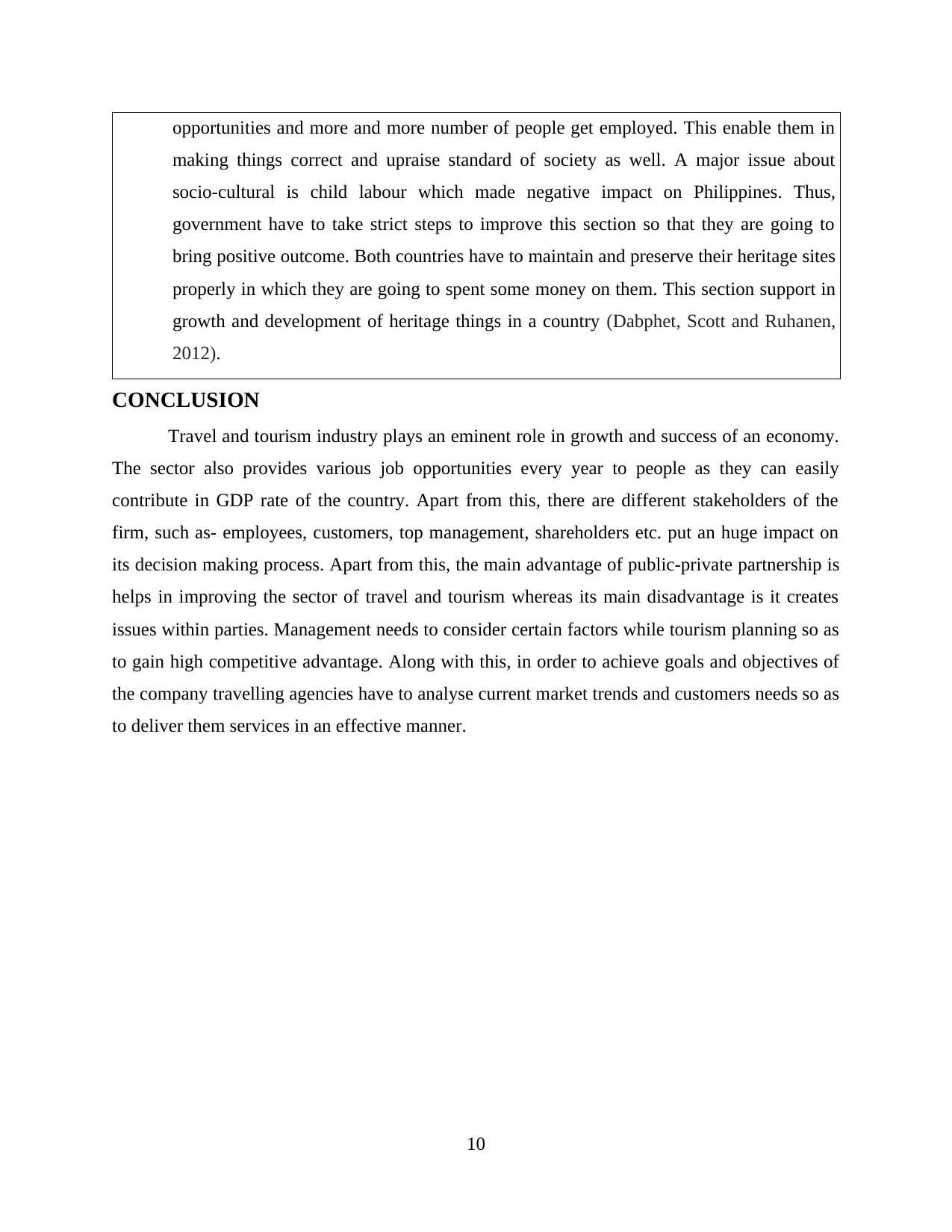
opportunities and more and more number of people get employed. This enable them in
making things correct and upraise standard of society as well. A major issue about
socio-cultural is child labour which made negative impact on Philippines. Thus,
government have to take strict steps to improve this section so that they are going to
bring positive outcome. Both countries have to maintain and preserve their heritage sites
properly in which they are going to spent some money on them. This section support in
growth and development of heritage things in a country (Dabphet, Scott and Ruhanen,
2012).
CONCLUSION
Travel and tourism industry plays an eminent role in growth and success of an economy.
The sector also provides various job opportunities every year to people as they can easily
contribute in GDP rate of the country. Apart from this, there are different stakeholders of the
firm, such as- employees, customers, top management, shareholders etc. put an huge impact on
its decision making process. Apart from this, the main advantage of public-private partnership is
helps in improving the sector of travel and tourism whereas its main disadvantage is it creates
issues within parties. Management needs to consider certain factors while tourism planning so as
to gain high competitive advantage. Along with this, in order to achieve goals and objectives of
the company travelling agencies have to analyse current market trends and customers needs so as
to deliver them services in an effective manner.
10
making things correct and upraise standard of society as well. A major issue about
socio-cultural is child labour which made negative impact on Philippines. Thus,
government have to take strict steps to improve this section so that they are going to
bring positive outcome. Both countries have to maintain and preserve their heritage sites
properly in which they are going to spent some money on them. This section support in
growth and development of heritage things in a country (Dabphet, Scott and Ruhanen,
2012).
CONCLUSION
Travel and tourism industry plays an eminent role in growth and success of an economy.
The sector also provides various job opportunities every year to people as they can easily
contribute in GDP rate of the country. Apart from this, there are different stakeholders of the
firm, such as- employees, customers, top management, shareholders etc. put an huge impact on
its decision making process. Apart from this, the main advantage of public-private partnership is
helps in improving the sector of travel and tourism whereas its main disadvantage is it creates
issues within parties. Management needs to consider certain factors while tourism planning so as
to gain high competitive advantage. Along with this, in order to achieve goals and objectives of
the company travelling agencies have to analyse current market trends and customers needs so as
to deliver them services in an effective manner.
10
⊘ This is a preview!⊘
Do you want full access?
Subscribe today to unlock all pages.

Trusted by 1+ million students worldwide
1 out of 13
Related Documents
Your All-in-One AI-Powered Toolkit for Academic Success.
+13062052269
info@desklib.com
Available 24*7 on WhatsApp / Email
![[object Object]](/_next/static/media/star-bottom.7253800d.svg)
Unlock your academic potential
Copyright © 2020–2025 A2Z Services. All Rights Reserved. Developed and managed by ZUCOL.





